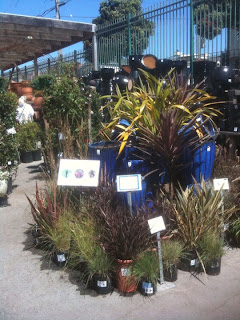
Original post from City Dirt
http://www.citydirt.net/newsletter/2010/07/21/the-perfect-peach.htmlPeople transplanted to Northern California usually have an "aha" moment when tasting their first peach at a farmer's market here. You realize that is how a peach should taste. While you may feel some bitterness toward all the past peaches you ate prior to this moment, the new world that open ahead of you diminishes this anger. A peach is not just a peach in Northern California. They have names that sound like shades of lipstick: Red Haven, Autumn Flame, and Cal Red.
According to Kashiwase Farm salespeople at the Marin County Farmer's Market at Civic Center, all varieties peaches--and nectarines and plums have their own characteristics and things to look for when picking them out, but the best way to pick out a perfect peach, generally speaking, is to look for the boldest colors. Don't look for pale or perfect. The more color, the more flavor. And when picking out nectarines, the speckles are from sugar, so the more blotches, the sweeter the nectarine.
Some of the late July and August varieties to look for include:
August Lady: Classic yellow peach, ripens in mid-August high quality fruit which is a firm, flavorful fruit with a rich, red color, crisp flesh texture at commercial maturity
O'Henry: You will find these at the markets from now until mid August. Choose the deepest red and purple fruits you can find; these have lots of flavor and are perfect for grilling. Toss them in summer salads with goat cheese or ricotta.
Cal Red: These are late summer golden-red beauties, found at Frog Hollow Farm at Ferry Plaza Farmer's Market and at the Edible Schoolyard. Make a peach cobbler out of these and your friends and family will love you even more.
White Opal: These are very pale and super-high sugar content and very low acidity. It has hints of vanilla and is perfect for making bellinis. (See recipe below).
Growing Your Own Peach Tree If you are a container gardener, the good news is, that you can grow miniature or dwarf peach trees in containers and avoid problems with a disease that commonly afflicts peach trees: leaf curl. Start with good, well draining soil. Use organic fertilizer and water regularly. When fruit starts forming on your peach tree, pinch off every third peach, or enough so that they will have plenty of room to grow and get larger. When selecting your fruit tree, keep in mind how many chill hours you have in the winter, how large the tree can get--do you want a dwarf or ultra-dwarf, and if you're going to get just one tree, it needs to be self-fertile. Keep in mind donut varieties like the Saturn Peach, as they have a delicious, delicate flavor, are small trees and require low chilling hours, which is great for California.
Recipe: Dry Creek Peach Bellini by Dry Creek Peach & Produce Puree all ingredients below:
½ c. water
1/4 c. (approximately) lemon juice
½ - ¾ lb. white peaches
2 tsps. sugar
Strain the puree and then pour into a pitcher (preferably glass). Add one bottle of chilled Prosecco or sparkling white wine and stir. Serve in chilled champagne glasses and enjoy!
 Roses are arriving in our stores this month! We carry only Grade #1 roses. They should have at least three canes. The canes should be at least as thick as a pencil, and look nice and plump with fresh-looking, smooth, green or reddish-brown “skin”. They should not be crossing, withered or wrinkled. The canes can also be pruned a little to direct outward growth.
Roses are arriving in our stores this month! We carry only Grade #1 roses. They should have at least three canes. The canes should be at least as thick as a pencil, and look nice and plump with fresh-looking, smooth, green or reddish-brown “skin”. They should not be crossing, withered or wrinkled. The canes can also be pruned a little to direct outward growth.













 \
\































